Unveiling the Best Lens Cleaner with 10 Essential Features You Need to Know
In the world of optical care, the significance of selecting the right Lens Cleaner cannot be overstated. According to a recent market report by Grand View Research, the global lens cleaning products market is expected to reach $2.1 billion by 2026, growing at a CAGR of 6.9%. This growth is driven by the increasing demand for high-quality lens care solutions among consumers concerned about the clarity and longevity of their eyewear. Effective cleaning not only enhances visibility but also contributes to the overall durability of lenses, making it essential for consumers to be informed about the critical features of lens cleaning products. This blog aims to unveil the best lens cleaner available on the market, highlighting ten essential features you need to know to make an informed choice, ensuring both performance and safety in your lens maintenance routine.

The Importance of Choosing the Right Lens Cleaner for Your Needs
When selecting a lens cleaner, it is crucial to understand its importance in maintaining the longevity and clarity of your optical devices. A suitable cleaner not only removes dirt and smudges but also ensures that your lenses remain scratch-free. According to recent industry reports, up to 80% of lens damage can be attributed to inappropriate cleaning methods or products. Therefore, opting for a lens cleaner specifically designed for your needs is essential to preserve the integrity of both eyeglasses and camera lenses.
Another key factor in choosing the right lens cleaner is the composition of the cleaning solution. Products that contain ammonia can lead to discoloration or damage on certain lens coatings. Research indicates that pH-balanced, non-abrasive cleaners are far superior, as they provide effective cleaning without risking harm to lens surfaces. Additionally, microfiber cloths are recommended for use with these cleaners, significantly reducing the potential for scratches. In a world where visual clarity is paramount, investing in a quality lens cleaner can greatly enhance your viewing experience, whether through eyeglasses or high-end camera equipment.
Unveiling the Best Lens Cleaner with 10 Essential Features You Need to Know
| Feature | Description | Importance |
|---|---|---|
| Non-Toxic Ingredients | Made with safe materials that won't harm lenses or users. | Protects health and lens integrity. |
| Microfiber Cleaning Cloth | Includes a high-quality cloth to avoid scratches. | Enhances cleaning effectiveness and protects surfaces. |
| Anti-Fog Feature | Prevents fogging on lenses. | Improves visibility in various conditions. |
| Quick-Drying Formula | Dries fast without streaks. | Saves time and maintains clarity. |
| Compact Packaging | Portable sizes for convenience. | Easy to carry for on-the-go cleaning. |
| Versatile Use | Suitable for glasses, cameras, and screens. | Multi-purpose use expands functionality. |
| Streak-Free Formula | Ensures no residue is left behind. | Maintains sharp vision and clarity. |
| Eco-Friendly Packaging | Recyclable materials used in packaging. | Supports sustainability efforts. |
| Effective Dust Removal | Easily removes dust and dirt. | Enhances cleaning process and results. |
| Affordable Pricing | Reasonably priced for regular use. | Accessible for everyone without compromise. |
Key Ingredients to Look for in an Effective Lens Cleaning Solution
When selecting an effective lens cleaning solution, understanding the key ingredients can significantly enhance your cleaning experience. The best lens cleaners typically contain ingredients like isopropyl alcohol and ammonia-free surfactants. According to the Eyewear Industry Report, these components are proven to break down oils and dirt without damaging anti-reflective coatings on glasses, ensuring a clear and safe clean.
Tip: Always check the label for these essential ingredients when shopping for lens cleaners to ensure you are getting a product that effectively removes smudges while protecting your eyewear.
Another key element to consider is the presence of anti-static properties in lens cleaners. Reports show that products with anti-static agents prevent dust accumulation and keep your lenses cleaner for longer periods. This is particularly beneficial for those wearing progressive or transition lenses, which are often more prone to static cling.
Tip: Look for lens cleaning wipes or sprays that emphasize their anti-static capabilities to reduce the frequency of cleaning, making your daily routine more efficient.
Top 10 Features that Make Lens Cleaners Stand Out
When it comes to choosing a lens cleaner, understanding the essential features that make them effective can significantly enhance your experience. One crucial feature to look for is a non-abrasive formula. This ensures that your lenses remain scratch-free while being thoroughly cleaned, making it ideal for delicate surfaces. Additionally, consider products that are streak-free, allowing for a crystal-clear finish that enhances visibility after cleaning.

Another important aspect is the convenience of the packaging. Spray bottles, for example, often provide easy application, while pre-moistened wipes are perfect for on-the-go cleaning. Additionally, a quick-drying formula can save you time, enabling you to handle your lenses without waiting for moisture to evaporate.
Lastly, it’s beneficial to choose lens cleaners that are safe for all types of coatings. Whether you have anti-reflective or blue light filtering coatings, a cleaner that works well with these features will prolong the life and clarity of your eyewear. Always remember to check for user-friendly instructions, as proper application can make all the difference.
How Quality Manufacturing Ensures Superior Lens Cleaning Products
Quality manufacturing is paramount when it comes to lens cleaning products, as it directly affects their performance and longevity. According to a recent industry report by the Lens Cleaning Solutions Association, over 70% of consumers indicated that the efficiency of a lens cleaner is a decisive factor in their purchasing decisions. Products made with high-quality materials and advanced manufacturing processes provide superior results in removing smudges, dirt, and fingerprints without scratching or damaging delicate surfaces.
When selecting a lens cleaner, look for essential features such as anti-static properties, non-toxic ingredients, and compatibility with various lens coatings. These elements can enhance the user experience significantly. For example, a cleaner that contains anti-static agents can help reduce the accumulation of dust and dirt, keeping your lenses clearer for longer. Additionally, opting for cleaners that are safe for all lens types ensures that you’re not risking damage to expensive eyewear or camera optics.
Tip: Always check for customer reviews focused on cleaning efficiency and safety to ensure you're choosing a product that has been validated by other users. Also, consider investing in microfiber cloths designed for lens cleaning, as they complement your cleaner and help maintain lens clarity over time.

A Comparison of Popular Lens Cleaners: What Sets Them Apart?
When it comes to lens care, not all cleaners are created equal. According to a report by the American Optometric Association, improper cleaning can not only damage lenses but also impair visual quality. Different lens cleaners serve varying purposes—some are alcohol-based, while others utilize microfiber technology. For instance, alcohol-based cleaners can effectively remove smudges but might damage anti-reflective coatings if used excessively. In contrast, microfiber cloths paired with lens-safe solutions prevent scratching while ensuring optimal clarity.
A recent comparative analysis by Vision Council outlined essential features that differentiate popular lens cleaners. Key attributes include the solution type, drying time, packaging, and ease of use. For instance, brands like Zeiss and LensCrafters offer fast-drying formulas that reduce streaking, appealing to those who prioritize efficiency. Meanwhile, eco-friendly options, such as those containing biodegradable ingredients, are gaining traction among environmentally conscious consumers. The versatility of packaging—sprays, wipes, or cloths—also impacts consumer preference, with many opting for compact, on-the-go solutions to maintain lens hygiene.
